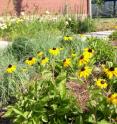Who influences purchases of native plants?
Native plants are a growing niche market in the southeastern United States. Researchers have documented recent trends toward increased interest in native plants by landscape architects, wholesale and retail nursery owners, and home gardeners. But landscape professionals and amateur gardeners purchase native plants for distinctly different reasons. Statistics reveal that landscape architects most often select native species because they are suited to difficult or unique growing conditions, while retail plant buyers purchase native plants based on recommendations from landscape architects and contractors. If landscape architects are the primary drivers of native plant sales in the southeastern United States, what impact does that have upon wholesale nursery growers and the retail market? What is the potential of the native plant market in this region, and what are the best ways of fostering its growth? To answer these questions, Robert F. Brzuszek and Richard L. Harkess, researchers at Mississippi State University, developed an e-mail survey for wholesale and retail nursery owners (members of the Southern Nursery Association) in the southeastern region of the United States. The survey results and recommendations were published in the latest issue of the American Society for Horticultural Science journal HortTechnology.
"The objective of this study was to understand how green industry professionals view the opportunities and constraints of the current southeastern native plant market, and to synthesize the connections between landscape architects' demands and the supplies of the nursery industry in the region", explained Brzuszek.
The survey respondents revealed that, while there is a perceived increase in customer interest in native plants, market demand and enhanced public education play a key role in further development of this growing market.
When asked the primary reason they carried native plants, respondents cited client request (25.6%), followed by ecological reasons (17.8%), adaptability to difficult site conditions (16.3%), and low maintenance issues (13.2%). These responses differed considerably from the responses of landscape architects, who replied that native plants were mostly used because of their ability to grow in difficult site conditions.
The study found that both nursery professionals and landscape architects see customer interest in native plants growing. Most respondents agreed that identifying methods to increase marketing of native plants was of significant interest. Survey respondents suggested that better and more information sources be provided for the general public, particularly through the use of specific marketing campaigns and point-of-purchase information. Presentations and displays at nursery trade shows were also recommended as effective methods for growers and retailers to learn about new native plant cultivars.
Source: American Society for Horticultural Science
Other sources
- Who influences purchases of native plants?from PhysorgWed, 25 Mar 2009, 20:07:11 UTC
